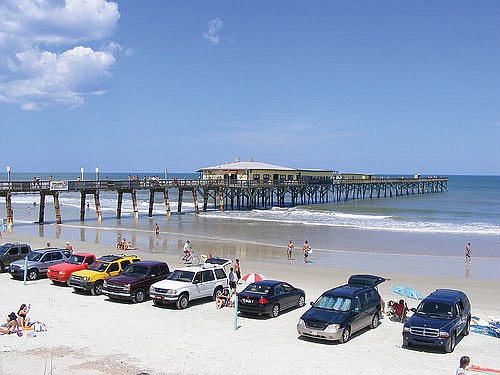- April 19, 2024
-
-
Loading

Loading

APRIL FOOLS — Tires will soon replace toes in the quartz sand of Siesta Key Beach.
Sarasota County commissioners voted March 19, to spend roughly $110,000 to hire a consultant to solve parking issues on Siesta Key public beach. The consultant will implement a staff-recommended plan to create a paid-parking area on the beach by June 1, according to staff emails.
County officials noted the anonymity of the consultant was to ensure a thorough planning process without intrusion from the business or residential community.
“I’ve found beach parking can become politicized,” said the consultant during an interview. “You would think sea turtles have their own personal lobbyists.”
The county has begun the permitting process to widen beach access No. 7, which would accommodate traffic from Ocean Boulevard and Beach Road to the proposed on-the-beach parking lot seaward of the Terrace Condominium Complex. County staff estimates that aspect of the project would cost $55,000.
“Environmental permitting is a long process,” said a Sarasota County Traffic Engineering and Operations staff member. “This way, when the consultant fine -tunes beach parking, construction can begin immediately.”
The consultant and county staff will discuss how to regulate the proposed lot, which would accommodate 250 vehicles. The lot would also come with up to 20 charging stations for electric vehicles.
“I always encourage communities to stay green-minded,” the consultant said.
Construction of environmentally friendly fencing around the lot would cost about $120,000, and an additional $40,000 would pay for cameras to discourage vehicle break-ins.
Parking meters, disguised in the shape of palm trees and surfboards, are one alternative to regulate the lot and pay for the bond that would be required for construction, the consultant said.
Another would be a seasonal parking-on-the beach permit pass that could range from $1,000 to $3,000 per season.
Siesta businesses could be assigned a special taxing district, similarly to what was done to build the municipal parking lot in Siesta Key Village, the county staff member said.
Northeastern communities, such as Cape Cod, Mass., and the Outer Banks islands in North Carolina, allow driving on the beach. In Florida, Daytona Beach is the most notable city that allows driving and parking on the beach.
Volusia County restricts parking to certain areas on Daytona Beach to protect dune vegetation and wildlife and encourages drivers to park perpendicular to the shoreline, according to the municipality’s website.
Sarasota County would have to shut the parking lot down during sea-turtle nesting season, the consultant said. And the current proposal includes turtle-friendly LED lighting and arrows pointed toward viable nesting areas to direct disoriented mothers-to-be.
“The parking plan is sensitive to sea turtles,” the consultant said. “But, I’ll have to work in some features to protect shore birds — price-dependent, of course.”
It could take up to three months for the consultant to finish evaluating the options for Siesta beach parking.
Staff had considered connecting a parking garage on the mainland with a monorail system, or using easements to build one public parking space at every residential property on Siesta.
“I don’t want to say those ideas are crazy,” the consultant said. “But, wasn’t crazy about them.”
Parking rules
Initial regulations for the parking lot on Siesta Key public beach include:
• Beachgoers are required to feed the meter every 30 minutes.
• Vehicles are required to back into the lot (see photo below).
• 100 spaces are designated for electric cars.
• 40 spaces are designated for carpool vehicles.
• Hood tanning is prohibited.
• No parking within 3 feet of sea-turtle nests.
• Turtle-friendly headlights are required during nesting season.